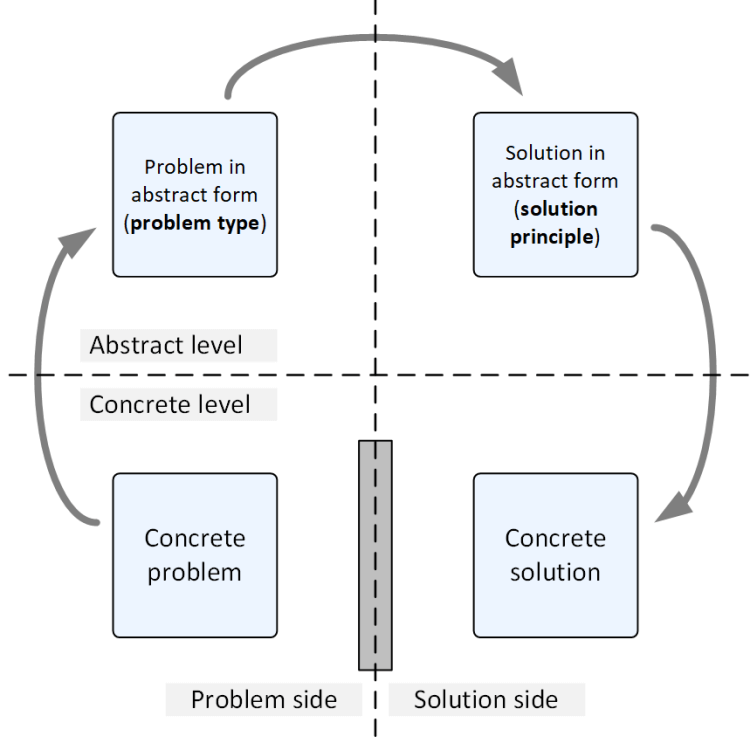A few words on systematic problem solving
While this website is mainly about presenting and communicating my method “MikaSolv”, this introductory page is about (systematic) problem solving in general. More precisely, on this page I share some basic thoughts about problem solving that I consider to be particularly important. If you like the topics of this page – the abstract and the systematic – you will probably love MikaSolv.

A task is not a problem
In the world of problem-solving, it is important to differentiate between a task and a problem.
A task is a clearly defined activity that requires a specific set of steps to be completed. Tasks are usually straightforward and don’t require much thought beyond following instructions.
On the other hand, a problem is a situation or challenge where the path forward – the path to the solution – is not clear at all. Therefore, and unlike tasks, problems require critical thinking, creativity, and maybe a strong problem-solving method to understand what it is about, and to find effective solutions.
While tasks can be a part of solving a problem, they are not problems in and of themselves. It is important to understand the difference between tasks and problems to effectively navigate the challenges we face in both personal and professional settings.
Differentiation from the topic of decision-making
While a decision and a problem may seem similar, they are two distinct things. A decision involves choosing between options where the outcome is known or can be predicted (and evaluated) with some degree of certainty. On the other hand, a problem involves an obstacle or challenge that needs to be overcome.
To approach a decision, one should gather information, brainstorm criteria, weigh the pros and cons, and make a rational choice based on available data.
To approach a problem, one needs to identify the underlying issue, generate ideas of possible solutions – and subsequently evaluate their effectiveness, and choose the best course of action.
In short, a decision is a choice between (known!) options, whereas the challenge in a problem is to find out how to overcome the obstacle and reach the goal in the first place. In other words, what is compared and weighed in decision-making is not yet given in problem solving, and must first be found.
So we see, solving a problem and making a decision are two different topics. However, it gets interesting when we look at how they are connected: They actually are related in a processual way, and they build on each other. And this is how it works:
- We first run into a problem. Once we are clear what it is,
- we think about solutions. Sometimes, more than one solution comes to mind, and some of them might be mutually exclusive, so
- we have to make a decision on which solution to actually implement.
However, this is blurred and often goes unrecognized, as
- our attempts to solve a problem often lead us to just one great solution. Or, rather, we stop working on the problem prematurely – that is, right after finding the first solution that is suitable to some extent. And it doesn’t even get to the point where we have to make a decision, and
- when we are facing a decision, it is not always apparent to us that the options at hand are alternative solutions for a problem, i.e., the results of some problem-solving steps that someone has gone through consciously (applying a problem-solving method) or unconsciously (just looking for a solution).

Not all problems we are facing are of the same type
I’m dealing with a problem when I have a goal and I can’t reach it (at the moment) because my path to the goal is blocked. That which stands in my way is the problem. In my problem-solving method and in my book, I assume that we can distinguish two basic problematic situations. In other words, two different things that are blocking our way to the goal.
To find out which type we are dealing with, we ask, “What is it that is preventing us from achieving this goal?” or a comparable question. The answer should reveal the nature of the problem we are dealing with.
- If the answer to the above question refers to mostly “external circumstances” that block the way to the goal, then it is a roadblock-type problem. This could be that something essential is not there, or there is too little of it; or something undesirable or disturbing is there.
- If the answer to the above question refers to the “inner circumstance” that I am pursuing another goal that is in contradiction to the actual goal that I have found, and these two goals are mutually exclusive and compete with each other for the same resources, then it is a dilemma-type problem.
How are problem-solving techniques and decision-making techniques related?
In reading literature in this field, I was repeatedly struck by the proximity of the topics of solving problems and making decisions. More precisely, the practice in which approaches and tricks for decision-making are being sold as problem-solving technique.
How abstract solutions help us solve problems
When faced with a problem, it is not always straightforward to find a concrete solution. This is where problem-solving by abstraction comes into play. The first step is to transform the concrete problem into an abstract form, which creates an abstract problem.
To solve this abstract problem, you can use a problem-solving method such as TRIZ for engineering problems or MikaSolv for business problems. By such a method, you can identify the type of abstract problem you are dealing with. Based on this, you can find one or many abstract solutions for the abstract problem.
Finally, you need to translate the abstract solution back into a concrete one. This involves asking the question, “What does this abstract solution mean when applied to the case at hand?” By answering this question, you can create a concrete solution that addresses the original problem.
Problem-solving by abstraction allows for a more efficient and effective problem-solving process by breaking down complex problems into more manageable abstract parts.
This is exactly the framework of MikaSolv, the method I describe in my book. The main focus is, first, on identifying the core problem – this is the precondition, so to speak, for translating the problem into abstract form. The second main focus is the use of a highly sophisticated, best-prepared, and maximally complete catalog of proven solutions that – you guessed it! – are available in abstract form.

Using analogies to solve problems
Problem-solving by analogy is a powerful technique that involves identifying similarities between a current problem and a previously solved problem. This method works on the premise that if two problems have similar characteristics, then the solution to one problem can be applied to the other.
For instance, if you have a problem of improving sales for a product, you could use the analogy of a football team that has been struggling to win games. Both scenarios involve the need to identify and address weaknesses in a system. By looking at the successful strategies implemented by winning football teams, you may be able to identify some key tactics that could be applied to your sales problem.
Let’s say you are facing the problem of increasing employee motivation in the workplace. One approach to solving this problem through analogy would be to compare it to the problem of improving student engagement in the classroom. Both situations involve finding ways to motivate individuals to stay engaged and focused on a particular task.
By looking at successful strategies used to increase student engagement, such as hands-on activities, personalized learning, and providing feedback, you may be able to identify ways to increase employee motivation in the workplace. For example, you could implement more team-building activities, offer more flexible work arrangements, or provide more opportunities for employees to give and receive feedback.

Does the project you’re working on feel like climbing a steep mountain? If so, imagine you are going on a mountain tour. Then ask yourself: what is especially important for your group to arrive at the top of the mountain as quickly, safely and elegantly as possible? What qualities should those who accompany you possess? And what are the greatest risks for which you should better be prepared?
As you can see from this example, working with analogies is not limited to problem solving. It can be just as useful for more general questions: how best to achieve a particular goal, or how to improve your skills in a particular field.
Are you ready to take the next step?
I hope you find these selected fields and aspects as interesting as I do. If so, I invite you to take a close look next at the method I’ve built based on these thoughts – and which I’m presenting to you on this website.
Stay tuned, it’s going to be exciting!

Get the book!
My book “Problem Solving for Professionals” has all the details. I launched it in Summer 2022, and you can order it from Amazon.
